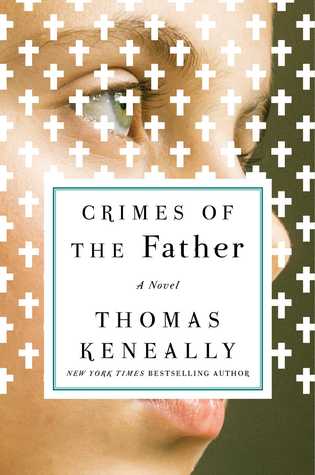This was excellent! Not the gut-punching read I anticipated when first reading. Rather, this is a gracefully written acknowledgement, and perhaps like a love letter to victims both directly and indirectly impacted by the abuse from Catholic priests and the Church.
It has similar tone to what was found in The Bishop’s Man, and definitely similar in the characer of Father (Dr.) Docherty and his torment and struggles with doing right by people but remaining called to his faith, just like Father Duncan MacAskill (The Bishop’s Man), and some of A History of Loneliness by John Boyne. Both of which I was hoping to find here in Crimes of the Father. (Faith is another excellent read similar to all of the above if you are interested. I highly recommend all three, or well, four now!)
In the Acknowledgments, Keneally (an ex-seminarian) writes about his friend, Father Pat Connor. Connor was expelled from the Church similarily for reasons like Docherty here in Crimes of the Father. Of Connor, Keneally says, “It was above all your example that caused me to retain a belief in the authenticity of Catholic spirituality, even if I am no archbishop’s model Catholic.” And I think this is how he genuinely wrote Crimes of the Father – to acknowledge the crimes of some priests and the Church, but expressing the spirituality and strength found in the Catholic faith – separate from the institution and some of the people in it. If that is making any sense, and not me blathering on incoherently. “Well- balanced” is a phrase I’ve seen often used by others that have read this book. I stayed up late to finish this, because I was truly glued to the pages, but my eyes fought me every chance, so I had to finish on the following day on a lunch hour at work.
I had many sticky notes stuck to the pages, and when sticky notes weren’t available, I took pictures of the pages.
Father (Dr.) Docherty is expelled from his archdiocese in Australia because of his work and stance on social justice issues. His protest work against the Vietnam War and other human rights issues are viewed infavourably for a priest and he is sent to Canada. There he becomes a psychologist and returns to Australia to speak on abuse in the Church and its role in acknowledging it. Upon his return he meets an ex-nun and reads a suicide note left by a young man, both indicting a now eminent monsignor for sexual abuse.
An indirect character in this is Maureen, and she was perhaps one of my favourites to read about, she was so very interesting- I’ve put many sticky notes throughout her parts. Really, all the characters are great (well, one is not). Maureen Breslin is a devout Catholic – and sister to Monsignor Leo Shannon – the priest now named as an abuser. Her views and beliefs about marriage, and her martial sex life all revolved strictly around Church’s approved rules. At one point, Maureen is waiting anxiously for the word to come down from the Pope on a more liberal stance on birth control in 1968. And when it did – only to confirm that the old rhythm method or abstinence were the only methods allowed for Catholics, Maureen collapses in grief. “Sometime after my visit to Father Docherty’s confessional, news had finally begun to spread that the Vatican was considering liberalizing their birth control doctrine. Now, some three decades later, we tell ourselves we should not have awaited the permission of old men in Rome…. The encyclical….Church’s divine mandate…”was that nothing artificial come between a man and a woman.”
“In the middle of the northern summer of that year, in Rome – or in Castel Gandolfo, where the Pope has his summer residence overlooking the lake – the word of the Lord, or of the Pope, came. It was the headline in the Herald on 26 July 1968. We were clubbed by the headline. Pope Paul VI had forbidden any method of contraception but abstinence and the dreary, unwieldy rhythm business.”
Once the Vatican released this mandate, even Maureen’s gynecologist went on TV acknowledging that “now Catholic women would need to go back to the rhythm method and accept as God’s will the child who was born due to the method’s significant inaccuracies.”
“American and other bishops howled, too, foreseeing the reaction from their flock, and were affronted that they had been invited to the Vatican to have their collegial say, yet much of what they had said had been ignored. Some Canadian bishops pushed the idea that the encyclical was only one of many authorities to be followed in this matter. Those who did not agree with it, they said, and who used modern contraception at the sanction of their own conscience, should not be separated from the Church…. And now their were no more diverse voices. The old world of a sole commanding voice was back, and I found that, to an extent I could not have predicted, I did not want it back.”
I sat amazed at how much Maureen allowed the doctrine of the Vatican to control her marriage and sex within her marriage. And also that medical doctors would also conform to the Vatican’s rulings for their Catholic patients. Today, I just don’t see how that would be the case, and Maureen as well acknowledges this with her comment about “three decades later” where she wouldn’t have allowed it either. I just couldn’t imagine this being the case for me, and I can distinctly remember telling our priest before our nuptials that there would be no readings allowed or vows taken where I would state anything containing “obey and submit”. (This priest argued vigorously with me saying that was the role of the wife, it is how it is written – and for Maureen, I couldn’t imagine she would have contested this with a priest.) Anyway…all this to say I was enthralled when reading about Maureen and her struggles with her devotion and against some of the dictates of the Church.
Anyway, the crux of this story is that Docherty comes home to Sydney to visit his aging mother and encounters separate stories on abuse by the same Monsignor – who is also Maureen’s brother. Maureen’s best friend’s son has committed suicide because of this abuse – “She had no peace, no means of approaching and engaging her grief, and Docherty felt the familiar anger emanating from her. He did not generally encounter it three times in a week, yet he had come home to find it in familiar suburbs where he had expected to have a holiday from it all.”
MaryG2E on Goodreads summarizes many of my thoughts on this book as well:
I was deeply affected by this novel on a personal level, so I don’t want to go into a detailed review of its content. I admired the approach taken by Keneally, to go back a few decades in our recent history, to look at the emergence of consciousness about this appalling abuse by clergy. He uses a light hand throughout, offering several points of view. Though he describes episodes of abuse, he does not dwell unnecessarily on the ghastly details. Rather, he focuses on the impact on the lives of the victims of clerical sexual abuse. He also draws interesting characterisations of the priests who perpetrated the abuse on children, which helped me to understand how the viciousness of their actions could be rationalised and excused away.
Most importantly, he tackles the thorny issue of the Catholic Church’s response to abuse, and takes them to task for their lies, deceit and attempts to silence victims. For me this was the most significant impact of the novel. I think he absolutely nails the attitude of the clerical hierarchy, with its overwhelming attitude of power and privilege, of being beyond criticism.
Again, I thought this was an excellent read. And like Mary comments above, it is a personal read, and like Keneally says, allows for maintaining spirituality and belief…but also provides a level of consciousness needed on this issue. I highly recommend, just as I highly recommend The Bishop’s Man, The History of Loneliness and Faith. These are all valuable reads but none of them sensationalize, which I appreciate.



This sounds like quite a powerful reading experience indeed. It does seem hard to believe that many of today’s grandmothers and mothers were forced to submit in ways that many women today find unconscionable. In some ways, much has changed. Then again, maybe not SO much.
Keneally wrote about it so wonderfully! I was really impressed, but ha! yeah, not so much on the actual control over their minds and bodies!